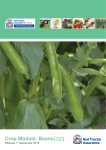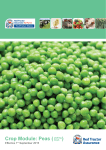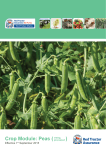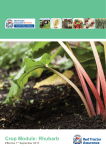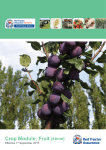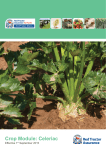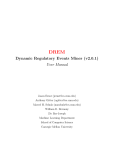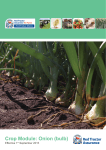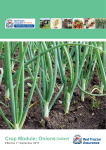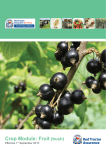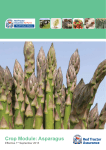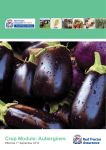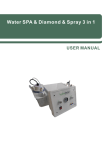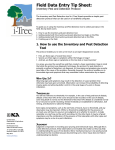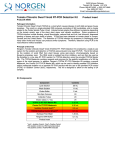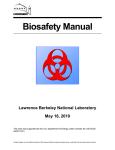Download Crop Module: Beans (Runner)
Transcript
Crop Module: Beans (Runner) Effective 1st September 2015 Welcome T his crop specific module for runner beans has been written to complement and avoid duplicating the generic principles of the Red Tractor Farm Assurance Fresh Produce Scheme standards. It is advisable to read the Red Tractor Farm Assurance Fresh Produce standards before reading this crop specific module. This module is designed to stimulate thought in the mind of the reader. It contains crop specific guidance and standards, where applicable, in addition to the requirements stated in the generic Fresh Produce standards. Within this module the important requirements outlined in the crop specific standards section will be verified during the Red Tractor Farm Assurance assessment and compliance will form a part of the certification/approval decision. Disclaimer and trade mark acknowledgement Although every effort has been made to ensure accuracy, Assured Food Standards does not accept any responsibility for errors and omissions. Trade names are only used in this module where use of that specific product is essential. All such products are annotated® and all trademark rights are hereby acknowledged. Notes: Pesticide Information General Introduction Following a systematic approach will help growers identify and manage the risks involved in crop production. This module is based on a typical crop production process and food safety, health & safety, environmental and quality hazards are identified. Appropriate controls may then be established to minimise risk. Food safety and health & safety issues always take precedent over quality and environmental controls. The layout of this module follows the same structure as that used in the Red Tractor Farm Assurance Fresh Produce Standards. The content of the module is reviewed prior to the issue of updated editions. The review process considers both new developments and all relevant technology which has emerged since the last review was completed and which have been found to be both workable by the grower and beneficial to the environment. The aim is to transfer such information and technologies to growers. Acknowledgements Red Tractor Farm Assurance Fresh Produce gratefully acknowledges the contribution of all consultees in the preparation of this protocol, particularly Anthony Biddle and Becky Ward of the Processors and Growers Research Organisation, and Cathy Knott. The Red Tractor Fresh Produce team has been working with Fera to provide tailored access to the LIAISON database for all Red Tractor Fresh Produce members. This system allows individual growers access to all information for plant protection products approved for use under the Red Tractor Fresh Produce Scheme. LIAISON can be accessed under the Produce tab via the “Checkers and Services” page where you will also find a user manual. Searches will be filtered specifically for the crops for which you are registered. Once you have logged onto the site and clicked on the LIAISON hyperlink you will be directed to the LIAISON home screen. You will need a username and password and these will be sent once you have registered: http://assurance.redtractor.org.uk/rtassurance/ services/Registration/members.eb . 1 Red Tractor Assurance for Farms – Crop-specific Module: Beans (Runner) © Assured Food Standards 2015 Content Contents ADDITIONAL REQUIREMENTS AGAINST CURRENT STANDARDS 02 CROP SPECIFIC STANDARDS02 SITE AND SOIL MANAGEMENT 03 ENVIRONMENTAL PROTECTION AND CONTAMINATION CONTROL03 NUTRITION 06 IRRIGATION07 RESIDUES AND CONTAMINANTS07 APPENDIX 1: TYPICAL APPLICATION RATES FOR NUTRIENTS 08 ADDITIONAL REQUIREMENTS AGAINST CURRENT STANDARDS None for this crop module CROP SPECIFIC STANDARDS None for this crop module Red Tractor Assurance for Farms – Crop-specific Module: Beans (Runner) © Assured Food Standards 2015 2 GUIDANCE SITE AND SOIL MANAGEMENT SITE HISTORY THE BASIC APPROACH TO CROP PROTECTION Climate Can be grown in most parts of England, but crops grown in warmer parts of the country mature earlier. Runner beans are very susceptible to frost damage. High winds can be damaging to climbing runner beans, causing pod scarring which reduces quality. A sheltered field is therefore desirable. Soil type A deep free draining but moisture retentive loam soil will encourage rapid establishment and steady, uninterrupted growth. Capping of the soil surface is detrimental where seed is sown. Crop rotation The guiding principle is that pesticide use should be minimised. An integrated approach should be adopted to achieve this involving the following management steps. Planning a. Sensible crop rotations to avoid build-up of problems b. Careful site selection to avoid potential or previous problems enhances crop health and cleanliness c. Inclusion of resistant varieties in cropping programmes whilst retaining the required quality parameters and eating characteristics. Cultural preventative techniques a. Good crop and field hygiene Crop rotation will help reduce the build-up of pests, diseases and perennial weeds. However, runner beans are often grown repeatedly on particularly favourable soils or where irrigation facilities have been installed, therefore, the more beneficial longer breaks are not always achievable. Fungal diseases such as foot rots or vascular wilt may develop after long term cropping and if such problems become apparent, then alternative sites for production must be found. Crop hygiene is also important, as pests such as two-spotted spider mite and rust disease can survive on crop debris or in canes etc. Corrective action Growing systems Where corrective or protective action is necessary the following approach should be adopted. b. Promoting crop health by ensuring effective nutrient availability through soil analysis and accurate application of fertilisers and trace elements c. Utilising available irrigation to promote healthy growth and as a control measure wherever appropriate and feasible. It is necessary to support the plants and to allow access for hand picking with paths between rows. Runner beans are grown in single or double rows and the plants are supported by canes, or strings laced between two horizontal wires. a. The need to take corrective or protective action must be established by regular monitoring and reference to established thresholds. The effect of prevailing and predicted weather conditions on the need for treatments must be considered At high plant density runner beans crop heaviest over the early and middle periods of the picking season, while those sown at lower densities give maximum yields late in the season. b. The availability and use of biological and natural methods of pest and disease control must be reviewed and applied if appropriate Runner bean seeds require gentle handling and they are sown with specialist precision drills or by hand. Runner beans are dependent on insects for pollination and hives of honeybees are sometimes introduced into the crop. 3 ENVIRONMENTAL PROTECTION & CONTAMINATION CONTROL c. Where chemical control is essential: n Runner beans are dependent on insects, for example bees, for pollination. Pesticides classed as harmful, dangerous or extremely dangerous to bees must not be used when runner beans are in flower. n The least toxic and persistent product should be selected with due regard to its efficiency and ecotoxicity. Red Tractor Assurance for Farms – Crop-specific Module: Beans (Runner) © Assured Food Standards 2015 n The minimum effective dose should be used. n An appropriate application method with effectively maintained equipment should be chosen. n Selective and spot treatments should be used whenever appropriate. APPROVED USES NOT INCLUDED ON THE PRODUCT LABEL In many circumstances, particularly for minor crops, product labels do not include all of the approved uses and growers wishing to check the approval notice of a particular product should note that this information is available using the LIAISON® search accessible via their Red Tractor Farm Assurance home page after logging in. A search on the ‘Extension of Authorisation for Minor Use’ page of LIAISON® by crop or product name should yield a results page. A click on the product name should link to a summary of the approval information. Near the bottom of the summary is the specific off-label or EAMU number (e.g. 0246/09) and this link will open up a pdf of the current document giving details of the extension of use. PEST CONTROL Bean seed fly (Delia platura) Attack by the larvae of the bean seed fly is usually first apparent due to partial or even total failure of seedlings to emerge. Surviving seedlings may be malformed with swollen stem bases and secondary fungal diseases often invade damaged tissue. Seedlings can be attacked at any time from April onwards. The fly lays eggs on the surface of freshly disturbed soil and the emerging larvae tunnel into newly planted and germinating seeds. The larvae are white, about 6-8mm long and have a pointed head end and blunt posterior. They can be found burrowing inside the seed or within the stems. Chemical control: The only effective means of chemical control is by using an insecticidal seed treatment. Seed, therefore, should be obtained pre-treated with a chlorpyrifos-based product. Cultural control: Eggs are laid on freshly disturbed soil and therefore attacks are less likely to be serious where seeds have been planted into a stale seedbed. Plastic mulches are also beneficial in preventing egg laying. For small-scale bean production, seedlings raised in pots or modules can be planted in the field to avoid damage. Bean aphid (Aphis fabae) Colonies of black aphid can often develop around the stalks of the flower clusters and can result in deformed, blemished, or poorly developed pods. Chemical control: Care must be taken to avoid the use of insecticides that are harmful to bees during flowering. Where aphids are known to occur regularly each year, insecticide granules should be applied before flowering. Two-spotted spider mite (Tetranychus urticae) Attacks are more pronounced in dry seasons. First signs of infestation are small white patches on the leaf surface, which indicate the position of colonies of young mites on the underside. As the infestation develops, the leaves become more speckled, chlorotic and may turn a bronze colour. Plant growth, pod set and yield can be severely affected. The colonies on the undersides of the leaves produce fine white webbing, within which the mites and eggs can be seen. Chemical control: There are no approved chemicals for two-spotted spider mite control in runner beans. Cultural control: Hollow bamboo canes provide an overwintering site for the mite. As the temperature rises in early summer, the mites leave the canes and infest the young climbing plants. After a severe infestation, there may be some benefit in exposing covered canes to sunshine in early spring to encourage mites to swarm. More frequent replacement of canes should also be considered. Biological control: Predator control of red spider mite is becoming more widely used, but the introduction of the predator (Phytoseiulus persimilis) must be made early in the season and repeated after two or three weeks. Where infestation builds up late in the season, particularly in a hot dry summer, a further introduction of predators will help to reduce the overwintering population. Capsids (Lygus spp.) Capsids (plant bugs) can be a problem in some areas. They overwinter as adults on evergreen foliage and in all types of leaf litter. They emerge from their overwintering sites in late spring and can feed on a wide range of plants. The main damage to runner beans occurs just after pod formation, when the adults puncture the pod with their hollow piercing-sucking mouthparts. While feeding, the capsids secrete a toxin from their salivary glands, which kills the tissue surrounding the feeding site. The puncture marks are therefore discoloured and the pod may become malformed. Chemical control: Insecticides applied for caterpillar control will also reduce the amount of damage caused by capsids to the production of the early pods. Cultural control: Try to avoid planting beans in close proximity to large hedges or areas of perennial vegetation, which are ideal overwintering sites for aphids. Red Tractor Assurance for Farms – Crop-specific Module: Beans (Runner) © Assured Food Standards 2015 4 Slugs (Deroceras and Milax spp.) In some areas, slugs are becoming a regular problem, particularly where early beans are grown under plastic covers. The slugs move easily on the inside of the wet plastic and cause damage to seedlings by rasping or tunnelling the young stems. Leaves may also be damaged. The effects are not to be confused with bean seed fly. Chemical control: Slug pellets or baits should be applied at the first signs of damage. They may need to be applied at regular intervals during the early part of the season until the young plants have become well established. Cultural control: Soils containing high levels of organic debris including straw are most likely to harbour slugs. Such debris should be well dispersed, chopped or spread and disced before ploughing in the autumn. DISEASE CONTROL Foot rot (Fusarium solani f. sp. phaseoli) /Wilt (Fusarium oxysporum f. sp. phaseoli) Both diseases are characterised by premature death of either individual, or groups of plants. Beans affected by foot rot may be stunted, with pale foliage that eventually withers and dies. The root system is poorly developed and dark brown to black in colour and the vascular tissue within the root and stem base may be brick red in colour. Beans infected by the wilt fungus usually begin to show symptoms during flowering, when the weather is warm. The older leaves become chlorotic generally around the margins at first, and then the whole leaf becomes dry and brittle. There may be leaf rolling and yellowing of the younger leaves as the disease progresses, until the whole plant withers and dies. A brown discolouration of the vascular tissue may be seen within the stem, when cut lengthways. Chemical control: There are no effective means of control although soil sterilisation may reduce the risk of build-up of the pathogens in the soils. Cultural control: Both fungi are soil-borne and occur as a result of long term cropping. They are also encouraged by poor drainage and consolidated soil conditions and therefore good soil management should be maintained to avoid these problems. Where crops become infected, the ground should not be cropped with beans for a least ten years and where wilt has been confirmed, a longer period may be necessary. Halo blight (Pseudomonas syringae pv phaseolicola) Halo blight attacks the foliage and pods of beans. The disease is most destructive where temperatures are cool and rainfall is frequent. Halo blight is caused by a seedborne bacterium and has the ability to spread rapidly particularly during wet weather when pickers are moving regularly through the crop. 5 Infected seeds may give rise to yellow leafed seedlings with conspicuous green veins, however other environmental conditions may also cause this. Later these plants become the primary foci of infection. Infected leaves show small angular water-soaked spots about 3mm across and surrounded by a conspicuous yellow area (halo). These spots can become larger and coalesce and then dry up causing the leaves to wither. Pods may become covered with waters-soaked spots from which a greasy substance exudes. Chemical control: There are no chemicals approved for control of halo blight. Cultural control: It is essential to use healthy seed. NIAB or Processors and Growers Research Organisation can test seed for the presence of halo blight. If an occasional infected plant is found, then this and surrounding plants may be removed from the field to help to reduce the inoculum level if wet weather conditions are imminent or if overhead irrigation is used. Botrytis pod rot (Botrytis cinerea)/Sclerotinia white mould (Sclerotinia sclerotiorum) Both diseases can be an occasional problem when wet weather conditions persist during the flowering and pod setting period. Botrytis is characterised by a grey ‘furry’ mould occurring on the pod and develops as a result of the flower petal sticking to the pod and becoming infected by the fungus. Sclerotinia produces a water-soaked soft-rot of the stem or pod which rapidly becomes covered with a mass of white fungal mycelium. The black resting bodies of the fungus may appear on or inside infected pods or stems. Chemical control: Fungicides applied at the beginning of flowering when weather conditions are wet and unsettled, help to prevent both diseases becoming established. However, a harvest interval of 14 days must elapse following application of cyprodinil plus fludioxonil and 7 days following iprodione. Azoxystrobin has an EAMU for Botrytis control. Cultural control: Excessive overhead irrigation during flowering should be avoided. The resting bodies (sclerotia) of Sclerotinia sclerotiorum can survive in the soil over winter and produce air-borne spores in the following summer. Runner beans should not be grown on soil where the previous crop was heavily infected, leaving a break of 4-5 years. Rust (Uromyces appendiculatus) The disease can occur at any time during the summer, but is more commonly found from early August onwards when humidity is high. Rust appears as reddish brown circular pustules (1-2mm diameter) on the leaves and stems, often surrounded by a halo of yellow tissue. Later, pods may become infected with the pustules which may Red Tractor Assurance for Farms – Crop-specific Module: Beans (Runner) © Assured Food Standards 2015 be blacker in colour. In severe cases, the plants defoliate, there is a reduction of flower production and pods fail to set. Chemical control: Tebuconazole (SOLA/EAMU), applied as soon as rust pustules are found, gives good control of rust. A second application can be made 14 days later if conditions encourage further disease development. Care must be taken to maintain the correct harvest interval. Soil fumigation A soil fumigant, dazomet, is sometimes used to sterilise weed seeds, and also soil-borne diseases, insects and nematodes. NUTRITION MAJOR NUTRIENTS Cultural control: Rust can survive on crop debris and the elimination of debris by removal or cultivations will help to reduce early infection. However, once a new infection has commenced, air-blown rust spores can travel by wind long distances. Overhead irrigation may be useful in suppressing infection during dry periods. Prior to cropping the field, nutrient status should be determined by soil sampling and analysis. Fertiliser application must be in accordance with crop needs and soil reserves. Nitrogen may be lost through leaching if applied too early. Particular care should be taken to avoid build-up of unnecessarily high levels of phosphorus in the soil as it can cause pollution of surface waters. WEED CONTROL Examples of typical fertiliser recommendation are given in RB209 2011 version. See Appendix. Runner beans offer little competition to weeds. They are particularly susceptible at early stages of growth, and later, weeds interfere with hand picking. The growing season is long and herbicides lack the persistence required to control weeds throughout. Some runner beans are covered by polythene film just after sowing until small plant stage and dry conditions may reduce the efficacy of a residual herbicide but it may also reduce weed emergence. Black polythene in particular will reduce weed emergence and it is also used in trickle irrigation systems and for water conservation. When the film is removed, post emergence herbicide should not be applied too soon or the soft growth will be damaged. In addition the system of growing with support means that post-emergence treatments are difficult to apply although vibra-jet sprayers may be used. Plastic crop covers must be recovered and re-used where possible or recycled, or disposed of at licensed landfill sites. Runner beans should not be grown on land infested with couch. Successive weed flushes can be encouraged to germinate by cultivations before sowing. If there is a danger of the seedbed drying out, a stale seedbed technique is used, i.e. weeds which emerge before the crop is sown, are killed with a non-selective herbicide (e.g. glyphosate). Herbicides There are now very few herbicides available, thus effective weed control has become extremely difficult. Phosphate and potash are applied as a base fertiliser before cultivations. Nitrogen is also applied just before cultivation, but no more than 100kg/ha, the remainder is applied when fully established. The Fertiliser manual (RB209) - runner beans can require a further top dressing of up to 75kg N/ha at early picking stage. Where rain or irrigation can be relied on, so that nitrogen is moved into the root zone, a top dressing may be applied, often at early picking stage. Nutrients are sometimes applied in trickle irrigation (fertigation). Organic manure (FYM) is also very beneficial not only for supply and nutrients but for soil improving qualities. Where FYM is used adjustments to the balance of mineral fertiliser are necessary. If FYM is used, retailers must be consulted first and appropriate measures are taken to reduce the risk of E-coli. The guidelines in ‘Managing Farm Manures for Food Safety: Guidelines for Growers to Minimise the Risks of Microbiological Contamination of Ready to Eat Crops’ should be followed (http://www.food.gov.uk). The guidelines in the Code of Good Agricultural Practice for the Protection of Water should be followed, for example, avoid application of FYM in the wet autumn months. Inoculation Effective strains of nitrogen-fixing Rhizobia bacteria which nodulate runner beans rarely occur naturally in UK soils. Where they are present, nitrogen fertiliser suppresses their nitrogen fixation. Granular inoculants of Rhizobium are available for runner beans that can be incorporated with the seed. Red Tractor Assurance for Farms – Crop-specific Module: Beans (Runner) © Assured Food Standards 2015 6 Lime and pH IRRIGATION Runner beans require a pH of at least 6.5. If the pH is below 5.5 they are likely to suffer from poor growth and an application of lime will be needed. Over-liming should be avoided as it can induce deficiency of trace elements such as manganese. Trace elements Runner beans are responsive to irrigation. The abscission of flowers and pods is reduced, number of pods set and pod yield is increased. Irrigation during early flower bud stage has been shown to be the most important timing. Correction of soil moisture deficit during pod development may also be beneficial and overhead irrigation may reduce bean rust infection. Treatments should only be applied where a deficiency problem has been identified. Scheduling systems are useful to help forecast irrigation timing and the priority order. Manganese deficiency symptoms are chlorosis between veins and round margins of the leaves. It occurs where the soil is deficient or where manganese is unavailable to the plant and is common on peaty organic and sandy soils and where the pH is over 6.8. Soil analysis for manganese is of little value. The deficiency can be corrected with foliar sprays of manganese sulphate plus wetter. RESIDUES AND CONTAMINANTS Magnesium deficiency symptoms are interveinal chlorosis or necrosis of older leaves with leaf margins remaining green. It is uncommon but may occur on sandy acid soils and where there is excess potash. Soil analysis will identify the problem. At an index of 0 and if lime is also needed, correction can be made by an application of magnesium limestone (see Appendix) either before green beans are sown or elsewhere in the rotation. If crop treatment becomes necessary, corrective foliar sprays with magnesium sulphate should be applied. 7 Red Tractor Farm Assurance Fresh Produce is aware that a key area in the production of fresh produce which requires continued attention by growers and their advisers is that of keeping pesticide residues to a minimum. This issue is not just one of meeting the MRL trading standard but ensuring that any individual or multi residues are kept as low as possible below this level. The key targets are: n Optimising late applications of fungicides insecticides to the edible part of the crop n Optimising n Ensuring and the use of post-harvest treatments minimum harvests intervals are followed n Ensuring that application equipment is applying products correctly. Red Tractor Assurance for Farms – Crop-specific Module: Beans (Runner) © Assured Food Standards 2015 APPENDIX 1: TYPICAL APPLICATION RATES FOR NUTRIENTS Major nutrient requirements (kg/ha) (Source: Defra Fertiliser Manual RB209) Nutrient (kg/ha) Soil Index 0 1 2 3 4 5 6 Nitrogen (N) 180 150 120 80 30 0(2) 0(2) Phosphate(P2O5) 200 150 100 50 0 0 0 Potash (K2O) 200 150 0 0 0 0 Magnesium (as MgO) (1) 100 50 0 0 0 0 100(2-) 50(2+) 0 Notes: (1) Magnesium is not necessary for every crop and can be applied elsewhere in the rotation as magnesian limestone on acid soils. (2) small amount of nitrogen may be needed if SMN A levels are low in the 0-30cm of soil. At low soil indices of 0 or 1 (ADAS classification) the recommendations for phosphate and potash are adequate to increase yields and also to leave a residue that will build up soil reserves over a number of years. At indices of 2 or above, yield increase from phosphate or potash may be small. No more than 100kg/ha of nitrogen should be applied to the seedbed, the rest when the crop is fully established. A top dressing of 75kg/ha may be applied at early picking stage. Where FYM is used, reduce the amount of fertiliser accordingly. Consult your retailer before using FYM. Runner beans are classed as “Ready to Eat” crops - i.e. they can reasonably be expected to be eaten without any further processing to reduce microbial contamination, other than by washing. The guidelines in ‘Managing Farm Manures for Food Safety: Guidelines for Growers to Minimise the Risks of Microbiological Contamination of Ready to Eat Crops’ should be followed (see FSA website http://www.food.gov.uk) Select fields carefully to avoid risk of indirect contamination via surface run-off from manure heaps or stores, and during or following spreading of manures on the land. Treated or batch stored solid manures and slurries can be applied before sowing. You should not apply fresh solid manures and slurries within 12 months of harvest, subject to there also being a minimum of 6 months between application and sowing. Ensure water sources used on the farm are not contaminated with manures or run-off. Do not harvest pods touching the soil. Untreated and digested sewage sludge must not be applied within the crop rotation. Only advanced treated sewage sludge maybe used within the crop rotation and it must not be applied within 10 months of harvest. Applications may be carried out in accordance with the Regulations and the current Defra Code of Practice for the Agricultural Use of Sewage Sludge. PGRO technical publications Copies of various publications on pea and bean production, herbicides and pesticides are available to PGRO levy payers from: Processors and Growers Research Organisation The Research Station Great North Road Thornhaugh Peterborough PE8 6HJ Tel: 01780 782585 Web: www.pgro.org Technical updates are downloadable from the website at www.pgro.org Red Tractor Assurance for Farms – Crop-specific Module: Beans (Runner) © Assured Food Standards 2015 8 NOTES 9 Red Tractor Assurance for Farms – Crop-specific Module: Beans (Runner) © Assured Food Standards 2015 Certification Bodies Your routine point of contact with the Scheme is through your Certification Body. Certification Bodies are licensed by Red Tractor to manage membership applications and to carry out assessment and certification against the Standards. The table below shows which Certification Bodies apply to each enterprise. Certification Body NSF Kiwa PAI SAI Global SFQC Beef and Lamb Dairy Combinable Crops and Sugar Beet Fresh Produce 4 4 4 4 4 4 4 4 4 4 4 4 4 4 4 4 NIFCC (Northern Ireland) 4 QWFC (Wales) 4 Pigs Poultry 4 4 4 4 4 4 4 NSF Certification Kiwa PAI Hanborough Business Park Long Hanborough Oxford OX29 8SJ Tel: 01993 885739 Email: [email protected] Web: www.nsf-foodeurope.com The Inspire, Hornbeam Square West, Harrogate, North Yorkshire HG2 8PA Tel: 01423 878878 Email: [email protected] Web: www.kiwa.co.uk/pai SAI Global Assurance Services Ltd PO Box 6236, Milton Keynes MK1 9ES Tel: 01908 249973 Email: [email protected] Web: www.saiglobal.com/assurance QWFC SFQC Ltd NIFCC [Northern Ireland] QWFC [Wales] Royal Highland Centre, 10th Avenue, Ingliston, Edinburgh EH28 8NF Tel: 0131 335 6605 Email: [email protected] Web: www.sfqc.co.uk Lissue House, 31 Ballinderry Rd, Lisburn, Northern Ireland BT28 2SL Tel: 028 9263 3017 Email: [email protected] Web: www.nifcc.co.uk PO Box 8, Gorseland, North Road Aberystwyth SY23 2WB Tel: 01970 636688 Email: [email protected] Web: www.wlbp.co.uk T: 01932 589 800 E: [email protected] www.redtractorassurance.org.uk Fresh Produce Standards












